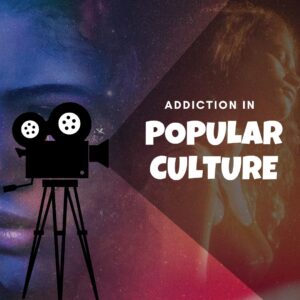Understanding Addiction in Media
Addiction is a multifaceted issue affecting millions worldwide. Its portrayal in popular culture plays a crucial role in shaping public perception. Media, with its vast reach, influences how society understands and reacts to addiction.
Misleading Depictions in Media
Simplistic Portrayals
In many films and TV shows, addiction recovery is often oversimplified. These portrayals usually show a rapid journey involving a few days of withdrawal, group therapy, and miraculous transformation. Unfortunately, they rarely depict the use of medication, a vital part of many recovery processes.
Impact of Shows Like Euphoria
 Shows like Euphoria have had a profound impact on public perceptions of addiction, particularly among young audiences. The series is lauded for its raw and unflinching portrayal of substance use disorder through the character of Rue Bennett, highlighting the chaos, trauma, and cyclical nature of addiction. By depicting the emotional turmoil, relapses, and the strain that addiction places on relationships, Euphoria brings much-needed visibility to the complexities of substance use and the importance of empathy and systemic change in addressing these issues. The show also explores the connection between addiction and co-occurring mental health disorders, emphasizing that recovery is not linear and that relapse is a common part of the process.
Shows like Euphoria have had a profound impact on public perceptions of addiction, particularly among young audiences. The series is lauded for its raw and unflinching portrayal of substance use disorder through the character of Rue Bennett, highlighting the chaos, trauma, and cyclical nature of addiction. By depicting the emotional turmoil, relapses, and the strain that addiction places on relationships, Euphoria brings much-needed visibility to the complexities of substance use and the importance of empathy and systemic change in addressing these issues. The show also explores the connection between addiction and co-occurring mental health disorders, emphasizing that recovery is not linear and that relapse is a common part of the process.
However, Euphoria has been critiqued for its limited depiction of recovery options, often focusing on spiritual or moralistic paths such as 12-step programs and inpatient rehab while neglecting the broader spectrum of evidence-based treatments available for addiction. This narrow focus risks creating a one-size-fits-all impression of recovery, which does not reflect the diverse needs and experiences of those battling substance use disorders. Experts point out that effective addiction treatment often requires a combination of approaches, including therapy, trauma-informed care, medication-assisted treatment, and harm reduction strategies—many of which are underrepresented in the show. By not fully addressing these complexities, Euphoria may inadvertently oversimplify the recovery process, potentially influencing viewers to misunderstand the multifaceted nature of addiction treatment and the individualized paths to recovery.
Citations:
- https://www.thenationalcouncil.org/wp-content/uploads/2023/11/Youth-Substance-Use-Portrayal-on-TV.pdf
- https://www.flasprings.com/blog/is-the-hbo-show-euphoria-a-real-look-at-addiction/
Stigma and Stereotypes
Negative Stereotypes
 Cinema has long played a significant role in shaping public perceptions of substance use disorders (SUDs), often relying on negative stereotypes that portray individuals with addiction as violent, dangerous, or morally deficient. These depictions are not only misleading but also contribute to the broader stigmatization of SUDs, making it more difficult for those affected to seek help or be treated with empathy. For example, the film Reefer Madness (1936) notoriously depicted marijuana users as descending into madness and violence, fueling public fear and reinforcing the idea that drug users are inherently dangerous49. More contemporary films like Scarface (1983) and Requiem for a Dream (2000) also perpetuate the image of the “demonized addict”—characters whose substance use is closely linked to criminality, violence, or personal ruin, often without exploring the underlying causes or the humanity of those struggling with addiction.
Cinema has long played a significant role in shaping public perceptions of substance use disorders (SUDs), often relying on negative stereotypes that portray individuals with addiction as violent, dangerous, or morally deficient. These depictions are not only misleading but also contribute to the broader stigmatization of SUDs, making it more difficult for those affected to seek help or be treated with empathy. For example, the film Reefer Madness (1936) notoriously depicted marijuana users as descending into madness and violence, fueling public fear and reinforcing the idea that drug users are inherently dangerous49. More contemporary films like Scarface (1983) and Requiem for a Dream (2000) also perpetuate the image of the “demonized addict”—characters whose substance use is closely linked to criminality, violence, or personal ruin, often without exploring the underlying causes or the humanity of those struggling with addiction.
These cinematic stereotypes have real-world consequences. Research shows that such portrayals reinforce public stigma, leading to discrimination, social exclusion, and internalized shame among people with SUDs. This stigma can deter individuals from seeking treatment, lower self-esteem, and even impact the quality of care they receive from health professionals. By reducing complex individuals to one-dimensional caricatures, films risk perpetuating harmful myths and making recovery more challenging. A more nuanced and empathetic approach in media could help dismantle these barriers, encouraging understanding and support rather than judgment and fear.
Celebrity Influence
Celebrities wield significant influence over public perception, and the media often magnify their experiences with addiction. Frequently, these stories are sensationalized—tabloid headlines focus on dramatic relapses, arrests, or stints in luxury rehab, emphasizing scandal over substance. This approach can reinforce negative stereotypes, portraying addiction as a moral failing or a spectacle unique to the rich and famous, rather than a complex health issue that affects people from all walks of life. For example, the struggles of stars like Robert Downey Jr. and Demi Lovato have been widely publicized, sometimes highlighting their lowest moments rather than the realities of their recovery journeys. Such coverage can make it harder for individuals to seek help, as it perpetuates stigma and the misconception that addiction is a personal weakness rather than a treatable condition.
 At the same time, the media’s portrayal of celebrity addiction can have a dual effect. While sensationalism and glamorization can normalize risky behaviors—especially among impressionable audiences—there is also a growing trend of celebrities using their platforms to share honest accounts of their struggles and recovery. This openness can help destigmatize addiction, encourage empathy, and inspire others to seek help. However, the persistent focus on dramatic or glamorous aspects of celebrity addiction often overshadows the nuanced, ongoing challenges of recovery, creating unrealistic expectations for the public and those facing similar battles. Ultimately, the way celebrity addiction is depicted in the media shapes societal attitudes, either reinforcing harmful myths or, when handled responsibly, fostering greater understanding and support for those affected by substance use disorders.
At the same time, the media’s portrayal of celebrity addiction can have a dual effect. While sensationalism and glamorization can normalize risky behaviors—especially among impressionable audiences—there is also a growing trend of celebrities using their platforms to share honest accounts of their struggles and recovery. This openness can help destigmatize addiction, encourage empathy, and inspire others to seek help. However, the persistent focus on dramatic or glamorous aspects of celebrity addiction often overshadows the nuanced, ongoing challenges of recovery, creating unrealistic expectations for the public and those facing similar battles. Ultimately, the way celebrity addiction is depicted in the media shapes societal attitudes, either reinforcing harmful myths or, when handled responsibly, fostering greater understanding and support for those affected by substance use disorders.
Normalization of Substance Abuse
Social Acceptance
Media frequently normalize substance use, presenting it as a common coping mechanism. This portrayal makes substance abuse appear safe and socially acceptable, potentially increasing its prevalence among viewers.
Impact on Public Perception
Consequences of Inaccurate Portrayals
Inaccurate media portrayals can affect individuals’ willingness to seek help, diminish trust in medical professionals, and reduce personal advocacy. Such depictions create a power imbalance, making recovery more challenging.
Positive Portrayals
Conversely, when media depicts addiction as a treatable health condition, it can improve public attitudes and support for recovery initiatives. This shift can encourage more people to seek treatment and reduce the stigma associated with addiction.
Liberty Addiction Recovery Centers’ Approach
Addressing Misconceptions
Liberty Addiction Recovery Centers challenge media misconceptions by offering a comprehensive and personalized approach to addiction recovery. They emphasize the importance of understanding each individual’s unique needs.
Evidence-Based Treatments
Liberty uses evidence-based therapies, such as Cognitive Behavioral Therapy (CBT), to provide effective and personalized treatment plans. This approach ensures a holistic recovery experience.
Conclusion – Addiction in Popular Culture
Moving Towards Compassionate Understanding
Media has a responsibility to portray addiction as a treatable health condition, fostering a supportive environment for those struggling with addiction. Accurate portrayals can significantly impact public perception and reduce stigma.
Reach Out to Us
For those seeking support and treatment options, contact Liberty Addiction Recovery Centers. They offer personalized and evidence-based care to guide you or your loved one toward recovery.
FAQs – Addiction in Popular Culture
- How does popular culture typically portray addiction and recovery?
- Popular culture often simplifies the journey of addiction recovery, depicting it as a rapid transformation through brief withdrawal and therapy sessions, without acknowledging the complexities, such as the use of medication in treatment.
- What impact does media representation have on the stigma of addiction?
- Media frequently reinforces negative stereotypes by portraying individuals with substance use disorders as violent or dangerous. This contributes to the stigmatization of addiction, making it more difficult for affected individuals to seek help.
- How do shows like Euphoria affect viewers’ understanding of addiction?
- Shows like Euphoria can present a skewed vision of recovery by focusing on spiritual and moralistic paths rather than the intricate process involved in real addiction treatment, which includes personalized approaches and potentially medication.
- What role do celebrities play in shaping public perceptions of addiction?
- Celebrity portrayals of addiction often align with negative stereotypes and are sensationalized in media. This can hinder a nuanced understanding of addiction and reinforce harmful perceptions.
- What can improve public perception and reduce stigma around addiction?
- Accurate media portrayals that recognize addiction as a treatable health condition can foster public understanding and diminish stigma. This shift can encourage more individuals to seek treatment and support recovery initiatives.






